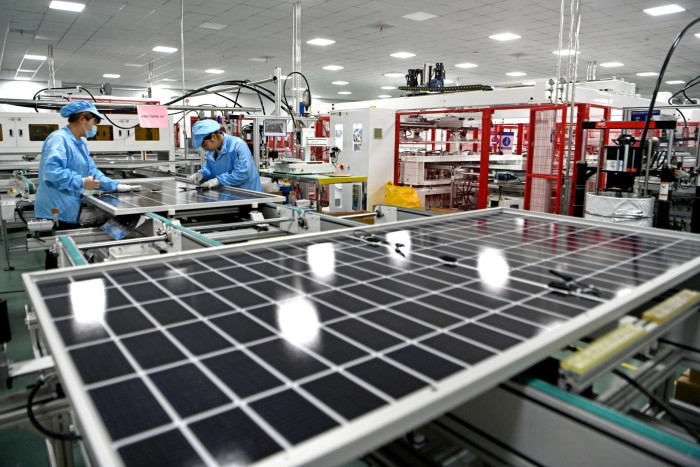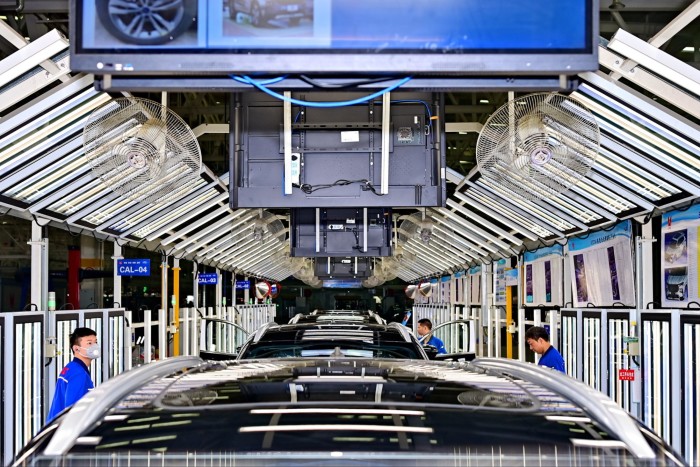Unblock the US election newsletter for free
Important stories about money and politics in the race for the White House
Just over a year ago, US Treasury Secretary Janet Yellen argued in a speech that Washington was not trying to break away from China, saying that a “complete separation” of the economies would be “disastrous” for both countries.
A week later, US national security adviser Jake Sullivan borrowed a phrase from European Commission President Ursula von der Leyen, saying that the US was pursuing a policy of “risk reduction”, not separation.
The rhetoric was designed to counter Chinese criticism that the U.S. is taking measures such as technology-related export controls to curb China’s rise.
Biden administration officials wanted China to understand that the United States would continue to take measures to protect national and economic security, even as the countries tried to stabilize relations that hit rock bottom after an alleged Chinese spy balloon flew over the United States.
The fraught relationship was back in the spotlight this week when President Joe Biden sharply raised tariffs on imports of Chinese electric vehicles and other clean energy products.
Beijing has accused the US president of reneging on his promise “not to seek separation from China”, while critics have accused Biden of pandering to workers in states such as Pennsylvania and Michigan – critical battleground states in November’s presidential election.
Others asked whether the Democratic president was using the tariffs as a weapon in an attempt to appear tougher on China than Donald Trump, his Republican rival in this year’s race for the White House, who unleashed a trade war with China in 2018 and recently vowed to hit all the country’s imports into the US with a 60 percent duty.
While Washington experts debated the merits of using tariffs to protect American industry, few saw the measures announced this week as either a “separation” or a sign of a new trade war.
Emily Kilcrease, a trade expert at the Center for a New American Security, a think tank, said the higher fees announced Tuesday on electric vehicles and other clean technology products, including batteries, are a “reinforcement of the de-risking agenda.”
De-risking is a term that covers everything from reducing security threats from Beijing to diversifying US dependence on Chinese supply chains.
According to her, Biden targeted the sector at the heart of the competition between the US and China, but added a new factor with tariffs. “Default policy tools such as export controls are completely ineffective in technology areas where China already has significant potential and . . . excess capacity in some cases.’
Cleet Willems, a former White House trade official in the Trump administration, had a different term that reflected the focus of the new measures on specific sectors.
“The contrast between complete separation and simple de-risking is too wide a gap,” he said. “This is a strategic junction.”

Until Tuesday, Biden had largely focused on security measures to stop China from acquiring advanced American technology such as semiconductors. Sullivan described this narrow strategy, focused on key sectors such as artificial intelligence, as a “small yard, high fence” approach.
The question for some has been whether Biden has changed tactics in appealing to the blue-collar voters he and Trump have been courting across U.S. industry.
After a legislative overhaul of tariffs that Trump imposed on $300 billion of Chinese goods during his trade war, Biden, who criticized the tariffs when they were imposed, left the charges in place but added other charges on clean energy products.
Willems said: “What you’re seeing is a lot of symbolism, obviously politically motivated.”

Emily Benson, a trade expert at the Center for Strategic and International Studies think tank, said it’s important to look at each product targeted by Biden’s new tariff regime. Curbing electric vehicle imports, for example, was hardly an example of decoupling, given that China’s auto sector and the US economy “were not significantly intertwined from the start.”
Doubling the tariff on Chinese semiconductors to 50 percent would also have limited impact because the U.S. imported few chips. In contrast, any targeting of finished products that included chips would represent a further step toward unbundling.
Brad Setser, a trade expert at the Council on Foreign Relations, said the best interpretation of the tariffs is that Washington is trying to prevent China from gaining a foothold in parts of the emerging U.S. clean energy sector.
“It was designed to avoid ‘bonding’ in sectors that historically have not been integrated, such as the auto industry, where China has not been a major source of supply to the US,” Setser said. “Since it doesn’t cover the rest of the trade, it doesn’t seem to me to lead to further separation.”